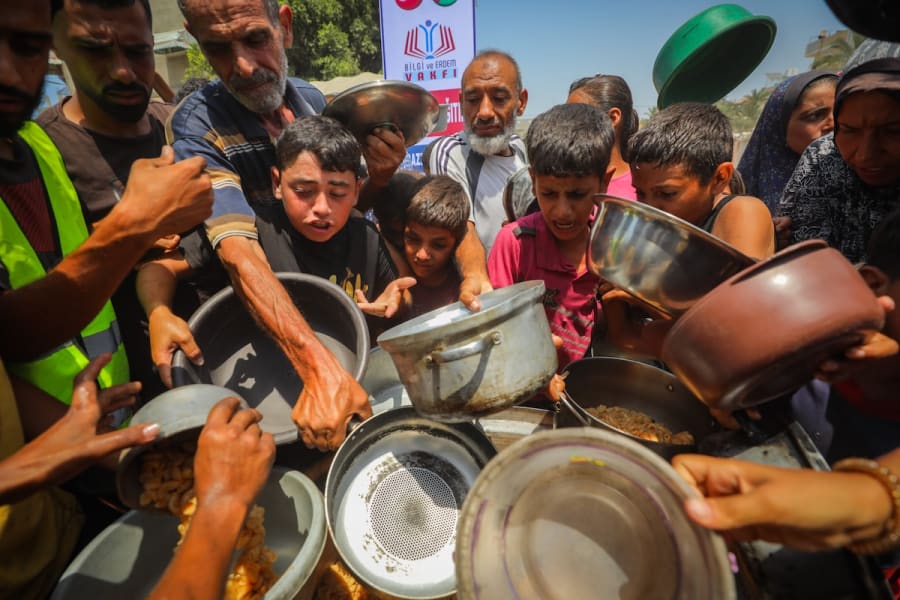UN-affiliated report lowered malnutrition measure to declare Gaza 'famine'

The UN-affiliated Integrated Food Security Phase Classification (IPC), a global, standardized system used to classify the severity and magnitude of food insecurity and malnutrition, recently declared a “worst-case scenario of famine” report for Gaza.
However, the IPC seemingly manipulated the conclusion by lowering the bar and using a new malnutrition measure that is usually not applied for famine determinations, The Washington Free Beacon reported on Tuesday.
The IPC report claimed that “mounting evidence shows that widespread starvation, malnutrition and disease are driving a rise in hunger-related deaths” in Hamas-controlled territory in Gaza.
The IPC is global coalition that consists of various UN agencies, Western governments and humanitarian organizations. The Free Beacon revealed that unlike past IPC evaluations, the Gaza report used the mid-upper arm circumference (MUAC), which has previously not been applied for determining potential famine. Furthermore, the IPC’s Gaza report notably reduced the percentage of children suffering malnutrition to 15%. Normally, famine is declared when 30% of the children in a specific territory suffer from acute malnutrition.
In addition, traditional methods for determining famine typically calculate both height and weight. This approach is labor-intensive but generally accurate. By contrast, the MUAC method used in the IPC Gaza report is simpler and quicker, as it focuses solely on arm circumference. It is also less accurate than traditional methods.
The IPC’s Gaza report de-emphasized its radically revised criteria, which is only found in a small asterisk below a chart with the title “When is Famine Classified?” In addition, the new criteria are not mentioned in the IPC’s official “Famine Fact Sheet.”
Additionally, the IPC’s manual list defines MUAC as a b supplementary data point and not the main indicator for famine determination. The IPC manual emphasizes that the IPC can only produce a “famine classification” when it has “reliable data” based on height, weight and other non-MUC measurements.
The implications of the new report potentially extend beyond Gaza and have already raised concerns among experienced aid workers.
“It’s a pretty big shift in standards,” one aid worker told the Free Beacon. “Lowering the bar makes it easier for a famine determination to be made,” the aid worker added.
Another aid worker stressed that previous famine declarations in Sudan, South Sudan and Somalia used the more precise 30% weight-for-height measurements. Even when using the less accurate MUAC-measurement, the IPC Gaza report indicated that malnutrition is below 8% for children in the cities Deir al-Balah and Khan Younis. The worst result was recorded in Gaza City – 16.5%, which is barely above the new significantly lowered 15% threshold but far below the traditional 30% benchmark.
The IPC Gaza report also cited “over 20,000 children” treated for “acute malnutrition” between April and mid-July. The data also included over 3,000 severely malnourished and 16 hunger-related deaths. However, all the data came from “internal documents” that are currently not available to the public. Notably, much of IPC’s data hails from the Hamas-controlled Gaza Health Ministry, which has at times distorted casualty figures in Gaza throughout the war and listed thousands of killed Hamas terrorists as “civilians.”
The IPC has so far refrained from responding to the Free Beacon’s questions concerning its changed measurement tools or the credibility of its data sources.
However, leading international media outlets like the New York Times, CNN and ABC News have already quoted the IPC report and blamed Israel’s aid restrictions for the alleged “mass starvation” in the Gaza Strip.
The Israeli military released on Tuesday new information that exposed the Hamas-driven “starvation campaign.” It concluded that most alleged “malnutrition” deaths in Gaza were attributed to pre-existing medical conditions and not related to famine. The purpose of the campaign has been to increase international pressure on Israel to end its military offensive against Hamas, which still holds 50 Israeli hostages including 20 who are believed to be still alive but have been deliberately starved by Hamas.
“Hamas’s ‘Starvation Campaign’ is a coordinated effort to mislead the public,” the Israeli military wrote on 𝕏.
“A thorough review by the defense establishment exposes how Hamas is misrepresenting deaths from pre-existing medical conditions as malnutrition to advance their political agenda,” the IDF added.

The All Israel News Staff is a team of journalists in Israel.
You might also like to read this:
















